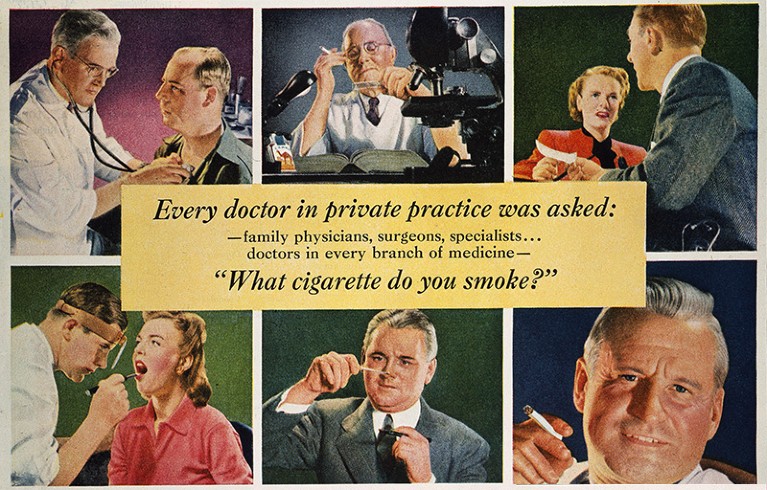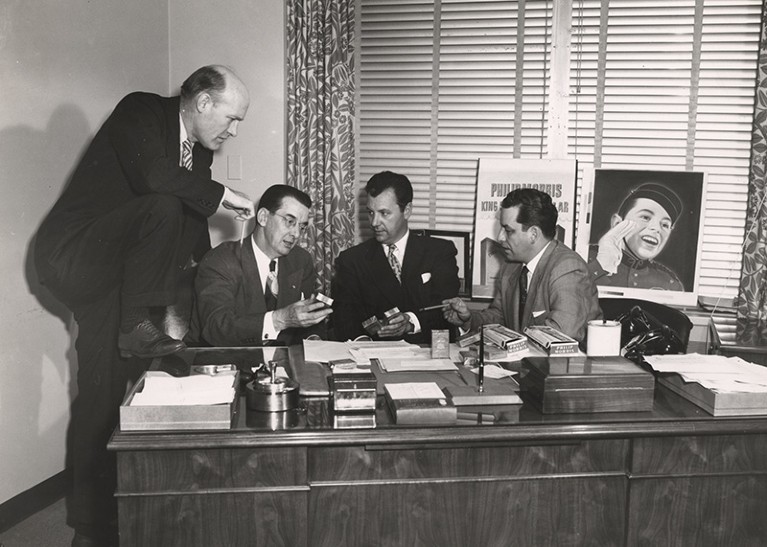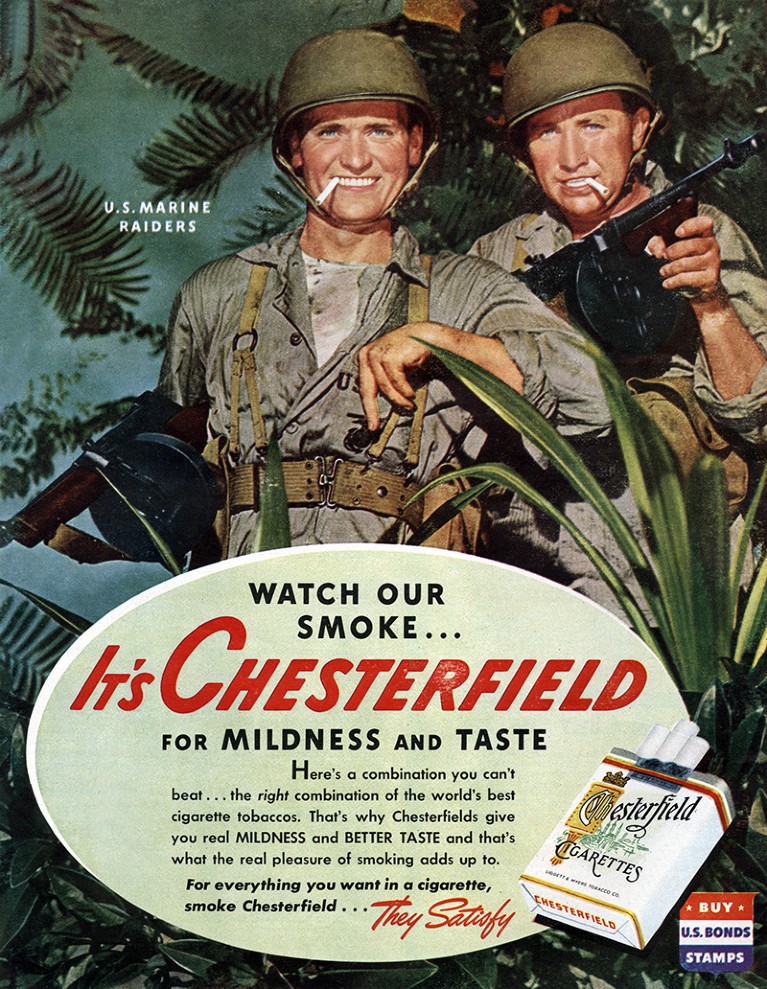
A US magazine advertisement from around 1950.Credit: Granger Historical Picture Archive/Alamy
The Cigarette: A Political History Sarah Milov Harvard University Press (2019)
The history of the tobacco industry, and its shameful campaign to delay regulation while millions died because of its products, might seem fully explored. Yet in her chronicle The Cigarette, historian Sarah Milov manages to bring fresh insight into how the industry’s power hooked government treasuries, the advertising business and scientists for hire, to trump public health for so long. Tobacco killed an estimated 100 million people in the twentieth century. Without radical action, it is projected to kill around one billion in the twenty-first.
Bending minds, building medicine
Many others have entered this reeking territory. They include journalist Richard Kluger, whose book Ashes to Ashes (1996) exposed the tobacco denial machine through hundreds of interviews with apologists and critics. In The Cigarette Century (2007), medical historian Allan Brandt interrogated cultural, scientific, legal and political evidence to explain how the industry created a global pandemic. The Golden Holocaust (2011) by science historian Robert Proctor mined millions of industry documents disclosed during litigation to produce an impassioned indictment of ‘big tobacco’, its plots and collaborators. Collectively, these catalogues of conspiracy go a long way towards explaining the persistence of smoking, decades after its potentially fatal impact was firmly established in the early 1960s.

Cigarette advertising was big business for much of the twentieth century.Credit: Weegee (Arthur Fellig)/International Center of Photography/Getty
What Milov adds is a nuanced account of the interplay between corporate machinations and government support for the industry from the 1930s until very recently. US state bureaucracies in tobacco-growing areas, and organizations such as the Farm Bureau that represented tobacco farmers in those states, are put forward as co-conspirators. Her focus is the United States, but the arguments apply to the global industry. And the parallels with, say, the spread of junk food long linked to obesity are all too clear — with companies using the same strategies and even the same lobby groups.
Corporate conspiracy
Much has been written about the tobacco industry deliberately obscuring the effects of smoking, not least by Naomi Oreskes and Eric Conway in the 2010 Merchants of Doubt. But during the First World War, the US federal government turned tobacco merchant itself. Classifying the industry as essential, it authorized the inclusion of rolling papers and tobacco in troops’ rations. When the Second World War presented another industrial crisis, the government stepped in again. Britain had stopped importing US cigarettes, to conserve foreign currency for its war effort. So the US government bought the volumes equivalent to the UK export market, to protect its own farmers.
The government had been bailing out tobacco farmers since the 1930s. The federal price-support system for tobacco began with the 1933 Agricultural Adjustment Act, part of president Franklin D. Roosevelt’s New Deal to combat the Great Depression. In 1964, US surgeon-general Luther Terry released the report ‘Smoking and Health’, concluding that smoking caused premature death from lung cancer, emphysema, bronchitis and coronary heart disease. Yet it was not until 2004 that federal price support was terminated, even though nearly half a million US citizens continued to die from tobacco-related deaths yearly. (Government payments to tobacco farmers continued until 2014, to soften the blow.)
Manipulating the market
During the cold war, Milov recounts, mass consumption of cigarettes was promoted by a burgeoning advertising industry. Smoking came to symbolize the triumph of consumer capitalism’s abundance over the dreary shortages of Soviet socialism. It was in this context that the Tobacco Associates was established in 1947. A marketing board to promote the sale of US surplus cigarettes overseas, it was a private organization mandated by government to collect a levy from industry to fund its efforts.

During the Second World War, the US government bought large volumes of cigarettes to make up for reductions in exports.Credit: Apic/Getty
This intertwined private and public policy effort — “associationalism”, to use the jargon of political economists — had a key role in spreading the global epidemic of smoking-related diseases. By 1955 in the United States, more than half of all men and nearly one-quarter of all women smoked. Finding new smokers in other countries was seen as key to continued growth. It still is.
The US Marshall Plan to rebuild a devastated Europe after the Second World War had included loans to buy US tobacco as well as food. From 1954 onwards, the plan evolved into the Public Law 480 programme of aid to allies, increasingly in southeast Asia, Latin America and the Middle East. More often known as the Food for Peace programme, it gave tobacco preferential terms, alongside food. The result was, as intended, the establishment of permanent export markets for US commodities and the building of US geopolitical hegemony.
Rotten meat and bottled formaldehyde: fighting for food safety
The effective counterpunch began in the late 1960s. When anti-smoking campaigners wanted to take on the nexus of industry, producer and state interests, they found two main routes to success. First, activists worked out how to harness the civil- and consumer-rights movements of the 1960s and 1970s to shift public perceptions of smoking and make it socially unacceptable. Young lawyer John Banzhaf, who founded the campaign group Action on Smoking and Health (ASH) in 1967, found ways to sue the industry. Faced with a federal legislature that sided with manufacturing and farming lobbies, campaigners took their fight to local government, where the corporate lobbying machine was less established. They worked with city administrations and specialist regulators, achieving a ban on US broadcast advertisements for cigarettes in 1971, and restrictions on smoking on aircraft in 1973 through the Civil Aeronautics Board.
Grass-roots activism
Working alongside them were grass-roots activists, on whom Milov has fascinating detail. Clara Gouin, a Maryland woman with a child allergic to cigarette smoke, founded GASP — the Group Against Smokers’ Pollution — in her living room in 1971. With others, she created the concept of the non-smoker, whose rights in public spaces were just as important as the smoker’s.

In debates over vaping, tropes generated by tobacco interests are re-emerging.Credit: Sergio Flores/Bloomberg via Getty
The second front in the fight was the push to prove that smoking was economically damaging — and not just to governments picking up health bills. Smoking harmed productivity. In 1976, another woman, Donna Shimp, brought the first case against an employer over smokers in her workplace making her ill. She went on to make the business case for banning tobacco in the workplace.
As ever, the callousness of tobacco’s defenders continues to shock. It is impossible not to be outraged by the Tobacco Industry Research Committee, a formal conspiracy between cigarette manufacturers, agreed in a hotel room in December 1953. The group spent more than US$300 million between 1954 and 1997 on manufacturing doubt about the science on smoking and health.
The World Health Organization estimates that more than eight million people still die each year from smoking. This is happening even as the same old tropes return in debates over vaping, following deaths among people using e-cigarettes. Weeds, as Milov puts it, are hard to kill. Meanwhile, try substituting fossil fuels and climate change for tobacco and premature death in this history. You will find the same outrageous industry efforts to subvert science — and the same glimmers of hope for a counter-movement.



 Rotten meat and bottled formaldehyde: fighting for food safety
Rotten meat and bottled formaldehyde: fighting for food safety
 Dominions of fizz
Dominions of fizz
 Bending minds, building medicine
Bending minds, building medicine
 When doubt becomes a weapon
When doubt becomes a weapon








